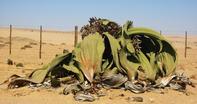
Name
Welwitschia (Welwitschia mirabilis) The welwitschia is a very strange plant with long, wide, strap-like leaves that grow on the ground. The plant only grows two leaves in its lifetime, which break into separate segments due to being whipped by the wind. Radiocarbon dating of the largest welwitschia plants show some are more than 1500 years old.Description
The welwitschia is commonly perceived as being weird or unlike other known plants. It is dioecious, meaning male and female organs grow on separate plants, and is perennial. Its two strap-like leaves grow atop the short, woody stem without branches from a basal meristem.
These two leaves grow throughout the plant’s lifetime, splitting and twisting in the wind. Stomata form on both of the leaves’ surfaces. Its stem widens with age, becoming a concave disc measuring a meter in diameter. From this stem ramifies small branch systems which carry pollen and seed cones, and reproductive shoots grow near the bases of the leaves.
On each branch grows two or three red pollen cones, not unlike those of the Ephedra. In each cone, a single seed grows and is scattered by the wind.
Characteristics
The leaves of the welwitschia have the longest longevity in the plant kingdom. The widest unbroken leaf recorded measured 179 cm and 6m long, yet only 3.15m of its length was living tissue. They are about 1.4cm thick.
Its split leaves annually grow approximately 13.8 cm, and therefore one welwitschia plant can grow 150 m of leaf tissue when growing for 1000 years. The leaves cover a great surface of desert sand, keeping the area under the leaves cool and moist in temperature, which can reach 65 degrees Celsius.
The leaves stretching across the sand also prevents sand erosion, staying still and rigid in the strongest of winds. The welwitschia absorbs water in a remarkable manner which, due to its leaves, has ensured its many years of survival. The absorption process goes as follows: the stomata stays open until the fog has lifted.
Water condenses on the leaves of the welwitschia, and directly take some of this water in. The stomata shuts when temperatures increase, preventing water from evaporating during the day.
Location
The welwitschia is endemic to the Namib Desert, located in the west of Namibia along the coast and stretching to Southwestern Angola. Most have been observed on a desert plain named Welwitschia Fläche, located 50 km east from Swakopmund and east from where the Khan and Swakop rivers converge.
This desert is one of the oldest deserts in the world, receiving an average of 100 mm some years, if any. It is an exceptionally arid region, and most plants are found growing in a fog belt 80 km from the coastline as they are reliant on moisture. The leaves of the mature welwitschia usually grow about 8 to 15 cm per year.
It has been recorded that some have measured 1.8 m in width and 6.2 m in length, which indicates that the plant could have a lifespan of 500 to 1000 years.
History
The welwitschia plant is eponymous to its discoverer – Friedrich Welwitsch. Welwitsch was an Austrian botanist who first researched and recorded the plant in 1860 in the Namib Desert in the southern regions of Angola.Dr Friedrich Welwitsch
Dr. Friedrich Welwitsch was born in Austria in 1806. He was a theatre critic for a while, and then fled to Portugal where he worked as a plant collector. Many years later, the Portuguese government dispatched him to Angola where he made more than 5000 collections during his 12 years in the country.
Some of his discoveries were entirely unknown and new to science then and his collections were valuable for its information and research. After living in Angola, Welwitsch lived in London in order to be close to the Natural Museum of History and the Royal Botanical Gardens, where he worked until his death in 1872.
The Portuguese government funded his collections, and tried to reclaim it from his estate executors in a long court battle. It took three years before a compromise was reached, which involved the Portuguese government receiving the first set of duplicates and the Natural History Museum the second. Dr. Welwitschia’s grave is in Kensal Green Cemetery in London, where his tombstone is decorated with an engraved welwitschia.